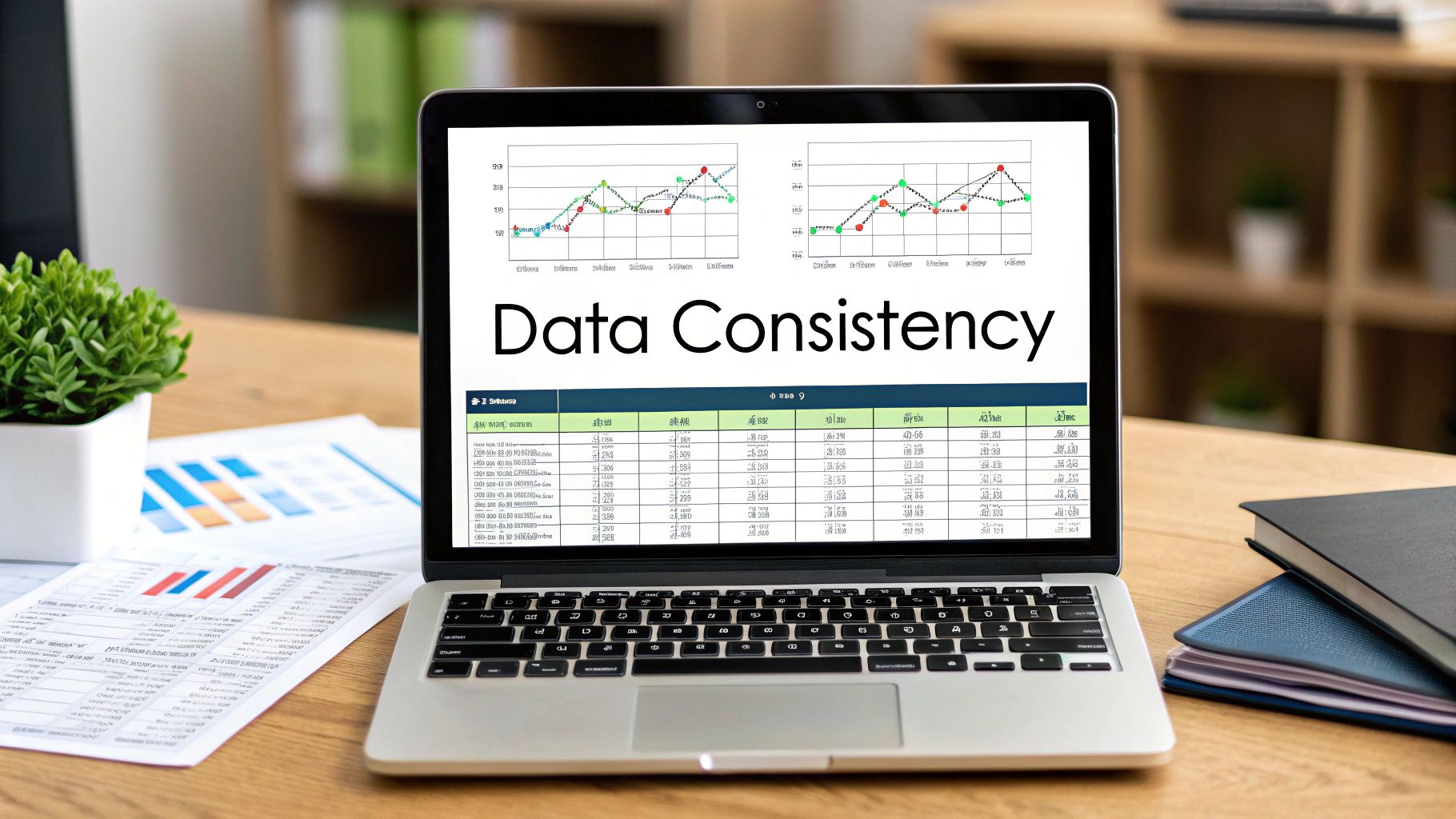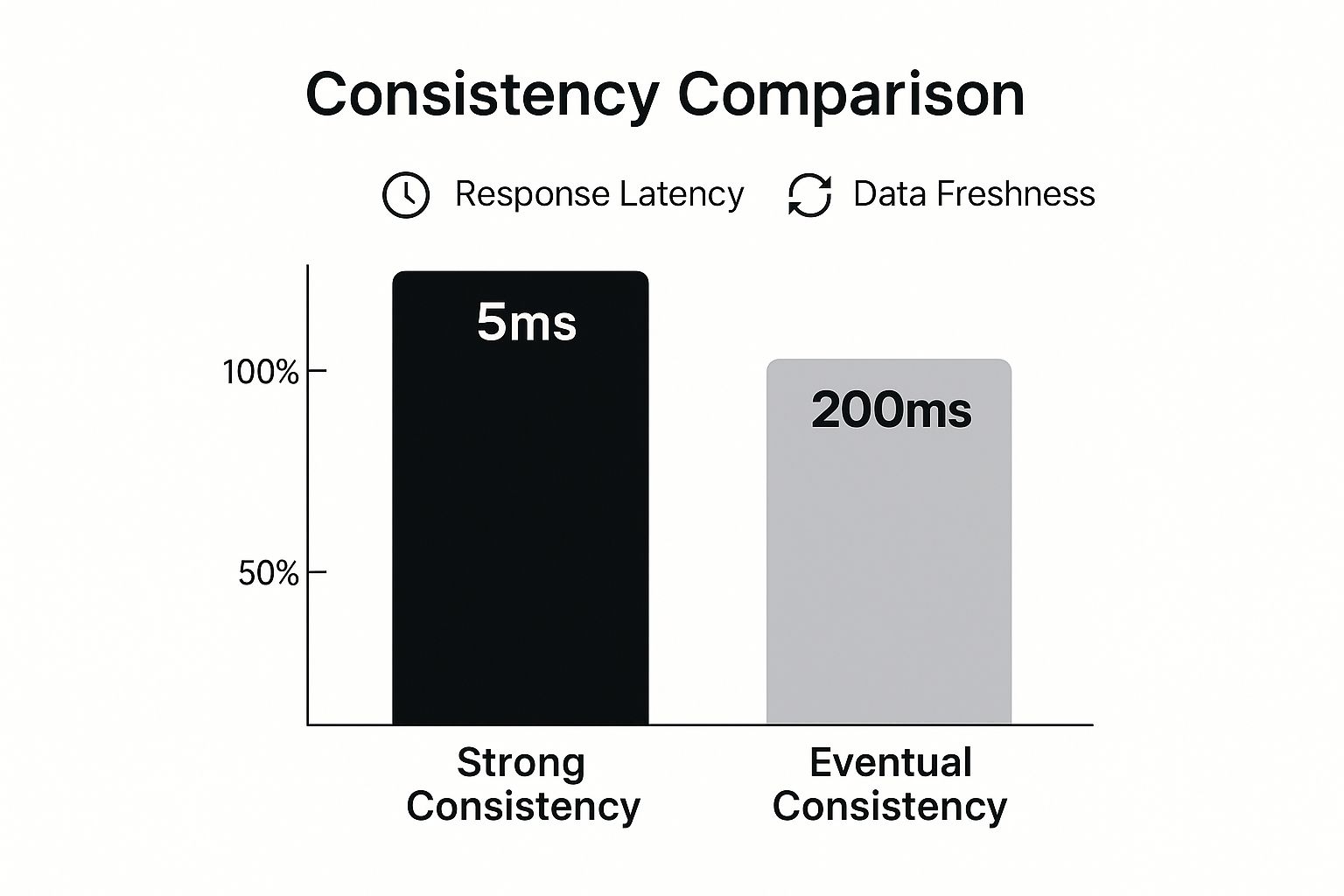What is Data Consistency? Key Concepts and Best Practices

At its core, data consistency is about making sure that the same piece of information is identical, accurate, and reliable no matter where you find it in your business. It’s the simple but powerful promise that everyone is working from the same script.
This principle is what stands between smooth operations and the costly, frustrating errors that pop up when data is out of sync across different departments or platforms.
What Does Data Consistency Look Like?
Imagine trying to bake a cake, but every cookbook you own lists a different amount of flour for the same recipe. One says two cups, another says three, and a third just says "a bit." You’d never get the same cake twice, and you'd likely end up with a mess. This is exactly the kind of chaos that data inconsistency creates in a business.

When your data is consistent, everything just clicks into place. A customer’s shipping address in your logistics software perfectly matches the one in your sales CRM. An employee’s job title is the same in both the HR system and the payroll software. This kind of alignment is the bedrock of trustworthy operations and sound decision-making.
Without it, you risk sending confusing or just plain wrong messages. Think about a customer receiving a marketing email for a product they just returned or seeing an incorrect account balance. Those little glitches erode trust and create poor experiences, all stemming from inconsistent data.
The Four Pillars of Data Consistency
To really get a handle on consistency, it helps to break it down into four core principles. Each one plays a distinct role in building a foundation of trust in your company’s information.
Here’s a look at what they mean in a practical sense.
The Four Pillars of Data Consistency
| Pillar | Description | Business Impact Example |
|---|---|---|
| Uniformity | Data is recorded in the same format everywhere. | All phone numbers are entered as (555) 555-5555, preventing CRM import errors. |
| Accuracy | Data correctly reflects the real-world entity it describes. | The product price listed on your website matches the price in your billing system. |
| Completeness | All required data fields for a record are filled out. | Every new customer record includes a valid email address for communication. |
| Integrity | Data relationships are maintained and valid. | An order record cannot exist without being linked to a valid customer ID. |
When these four pillars work together, they create a stable and reliable data environment. This idea is closely tied to the concept of a single source of truth, which is all about ensuring your entire organization is reading from the same, correct cookbook.
Why Consistent Data Is a Strategic Business Asset

It’s one thing to know what data consistency is, but it’s another to grasp why it’s so critical. Let's get straight to the point: consistent data isn't some technical jargon for the IT team. It's a core business asset that directly shapes your profitability, customer loyalty, and ability to stay ahead of the competition.
When data is inconsistent, it creates operational chaos that spreads throughout the entire company. Imagine a simple retail scenario: a customer sees a product marked "in stock" on your website and places an order. But hours later, they get a cancellation email because the warehouse system showed zero units.
That single discrepancy just caused a lost sale, created a frustrated customer, and chipped away at your brand's reputation.
The True Cost of Inconsistency
These seemingly small errors add up fast, creating a massive drag on your finances and operations. When your data can’t be trusted, every department feels the pain:
- Finance teams can't produce accurate reports, leading to shaky financial forecasts and potential compliance headaches.
- Marketing departments burn through their budget targeting the wrong people or sending mismatched offers because of conflicting customer profiles.
- Sales teams lose face when they quote an old price or promise a product that’s actually out of stock.
- Support staff are left dealing with angry customers who received contradictory information from different parts of the company.
This isn’t just theory. It's the daily reality for countless businesses that haven't prioritized data consistency. Simple tasks become complicated messes, and efficiency crumbles. For any company trying to improve its marketing ROI, for example, scaling ads using accurate data becomes impossible without a solid, consistent foundation.
Data consistency is the bedrock of trust. It means every decision—from a C-suite strategic pivot to a routine daily task—is based on information that is reliable and undisputed across the entire business.
Fueling Growth with Reliable Data
On the flip side, getting data consistency right is a powerful engine for growth. When everyone is working from the same, reliable playbook, the business becomes more nimble and effective. You can finally trust your analytics to give you a clear picture of market trends and customer behavior, paving the way for smarter decisions.
This reliance on clean data is why the global data analytics market is booming, projected to jump from $65 billion to over $400 billion by 2032. That explosive growth shows just how vital high-quality, consistent data has become for generating the insights modern businesses need to compete.
By treating your data with the respect it deserves and making consistency a priority, you build a solid foundation for innovation, efficiency, and a real competitive advantage.
Exploring Different Data Consistency Models
Data consistency isn't a one-size-fits-all concept. It’s more of a spectrum, with different models offering their own unique balance of trade-offs. The right choice for your business really boils down to what you need your data to do and how quickly you need it done.
Think of it like this: a group text message can arrive a few seconds late for some people, and the world doesn't end. But a bank transfer? That has to be instant and absolute. The money has to leave one account and appear in another at the exact same moment for everyone involved. Not all data carries the same weight.
Comparing Data Consistency Models
To get a clearer picture, it helps to see these models side-by-side. Each one is designed for a specific purpose, trading off things like speed, availability, and real-time accuracy.
| Consistency Model | Key Characteristic | Best For | Example Application |
|---|---|---|---|
| Strong Consistency | Data is always read as the most recent write. Guaranteed immediate. | Systems where accuracy is critical and cannot be compromised. | Online banking, e-commerce checkout, real-time stock trading. |
| Eventual Consistency | Data will become consistent over time if no new updates are made. | High-availability systems that can tolerate minor, temporary lag. | Social media feeds, DNS propagation, video streaming platforms. |
| Weak Consistency | No guarantees about the timing or order of updates. | Niche applications where performance is the absolute priority. | Certain high-performance computing tasks or VoIP calls. |
Ultimately, the model you choose depends entirely on the promises you make to your users and the operational needs of your business.
Strong Consistency: The Banking Model
Strong consistency is the strictest of them all. It’s a simple guarantee: whenever you ask for a piece of data, you will always get the most recent, up-to-the-millisecond version. Period. Once a change is made, every single subsequent request reflects that update instantly.
This is the gold standard for any system where precision is non-negotiable.
- Financial Transactions: When you move money, your balance has to update immediately. Otherwise, you could accidentally spend the same funds twice.
- Inventory Management: An e-commerce site needs to know the exact moment an item sells out to prevent overselling and disappointing customers.
- Booking Systems: Airlines can't have two people booking the same seat on a flight. Strong consistency ensures that once a seat is taken, it's instantly unavailable to everyone else.
This model puts correctness above all else, which can sometimes mean sacrificing a tiny bit of speed. Keeping every copy of the data perfectly aligned requires a moment of coordination, which might introduce a sliver of latency.
Eventual Consistency: The Social Media Model
On the other end of the spectrum is eventual consistency, a much more relaxed approach. It promises that if you stop making updates, all copies of the data will eventually match up. For a short period, different users in different places might see slightly different information.
This trade-off is perfect for large-scale systems where being fast and always available is more important than being perfectly synchronized every single second.
Eventual consistency is all about prioritizing a smooth user experience. It accepts that data will sync up in the background—usually in milliseconds—to keep the system responsive.
Think about posting on social media. Your new photo might appear on your own feed right away, but it could take a few seconds to show up for your friends on the other side of the world. A small delay in seeing a "like" doesn't break anything. This is why it’s great for:
- Social media feeds
- E-commerce product reviews
- Content delivery networks (CDNs)
This visual helps illustrate the core trade-off between the two most common models.

As you can see, strong consistency gives you perfect data freshness with a slight performance cost. Eventual consistency, on the other hand, prioritizes speed by allowing for a tiny window of inconsistency. Knowing which one to choose is about understanding what your business—and your users—can tolerate.
Finding and Fixing Common Data Inconsistencies

It’s one thing to understand data consistency in theory, but it's a whole different ball game when you're faced with a messy, real-world dataset. Making the jump from concept to practice means putting on your detective hat to hunt down the sources of chaos before they wreak havoc on your operations.
These inconsistencies don't just magically appear. They're almost always symptoms of deeper process issues, and a few common culprits are behind most of the headaches.
The Usual Suspects Behind Data Chaos
If you want to fix an error for good, you have to find its source. Most inconsistencies can be traced back to one of these five areas:
-
Simple Human Error: This is the most frequent offender. A simple typo during manual data entry, like putting "CA" in one record and "California" in another for the same state, creates an immediate problem that will skew your reports.
-
Flawed System Integrations: When systems don't talk to each other correctly—say, your CRM and accounting software—data gets jumbled. A customer’s updated address in one system might never reach the other, leaving your teams working with bad information.
-
Lack of Data Governance: Without a clear, company-wide playbook for data, every department makes up its own rules. Marketing might use "USA," while the sales team uses "United States," which means your database now thinks there are two different countries.
-
Concurrent Updates: Imagine two salespeople editing the same customer record at the exact same time. Without the right controls, one person’s changes can easily overwrite the other’s, resulting in a record that’s a jumbled, inconsistent mess.
This problem is only getting bigger as more companies rely on massive datasets for growth. The big data analytics market is expected to jump from $307.52 billion to an incredible $745.15 billion by 2030. And with around 60% of businesses using data to innovate, consistency isn't just a "nice-to-have" anymore—it's essential for getting insights you can actually trust. You can dive deeper into these trends in this PixelPlex.io report.
Becoming a Data Detective
Once you know what to look for, you can start putting strategies in place to catch these issues early. This isn't about pointing fingers when mistakes happen; it's about building a smarter, more robust system for your data.
A few key techniques can help you spot and fix problems before they derail important business decisions.
By actively monitoring your data, you shift from a reactive "firefighting" mode to a proactive state of control, where data quality is a managed and predictable asset.
A fantastic starting point is data profiling. This is where you analyze your datasets to get a clear picture of their structure, quality, and common patterns. It’s a fast way to uncover oddities like surprise null values or entries that aren’t formatted correctly. Another powerful defense is setting up validation rules right at the point of entry. For example, a simple rule can make sure all phone numbers are entered in a single, standard format.
Finally, performing regular data audits gives you a systematic way to review your most critical information. For anyone who lives in spreadsheets, adopting good habits here is non-negotiable. For some practical advice, take a look at our guide on Master Data Management in Excel. These practices help turn data maintenance from an emergency drill into a simple routine.
A Practical Framework for Maintaining Data Consistency
Spotting data inconsistencies is one thing, but fixing them for good requires a solid game plan. This isn't about quick, one-off cleanups. It’s about building a durable system that keeps your data consistent across the entire organization, shifting from constantly putting out fires to preventing them from starting in the first place.
This means setting clear rules, deciding on a single "master" source for your data, and weaving quality checks right into your team's everyday work. A good framework takes the fuzzy goal of "better data" and turns it into a concrete set of actions everyone can get behind.
Establish a Single Source of Truth
The single most effective step you can take for data consistency is creating a Single Source of Truth (SSOT). Think of it as the official, universally-agreed-upon home for your most important information, whether that’s a customer's address or the price of a product.
When everyone in the company knows exactly where to find the right data, it kills confusion. You'll stop seeing different departments working from their own conflicting spreadsheets. This one authoritative source becomes the gold standard that all other data is checked against.
Implement Robust Data Governance
To make your SSOT work, you need strong data governance. This is essentially the rulebook for how your company handles data. A solid governance policy doesn't have to be complicated, but it should clearly spell out a few key things:
- Data Ownership: Who’s ultimately responsible for keeping a particular set of data accurate and up-to-date?
- Standardized Formats: How do we enter dates, addresses, and names? (e.g., "Street" vs. "St.", "MM-DD-YYYY" vs. "DD/MM/YY")
- Access Controls: Who has the authority to add new data, change existing records, or delete them?
Strong Data Governance in Banking and other highly regulated fields is a must, but the core ideas are valuable for any business that relies on its data. Clear governance turns data management from a chaotic free-for-all into a disciplined, accountable process.
Enforce Validation at the Point of Entry
Your best line of defense against inconsistent data is to stop it from getting into your system in the first place. By setting up data validation rules right where information is entered, you ensure it meets your standards from the get-go.
This could be as simple as making a field mandatory or as complex as checking that a postal code matches a specific country's format. By catching errors at the source, you avoid countless hours of painful cleanup work later.
A proactive approach to data validation is 90% prevention and 10% cure. Focusing on quality at the source dramatically cuts down on expensive, time-sucking data correction projects.
Foster a Data-Aware Culture
Ultimately, rules and tools will only get you so far. True, lasting data consistency comes from a cultural shift. It happens when everyone in the organization understands why high-quality data matters and feels a sense of ownership over it.
This means training people on your data standards and, just as importantly, giving them tools that make it easy to do the right thing. When data quality becomes a shared responsibility, you create a powerful, self-sustaining cycle of accuracy and trust. To take this further, check out these 7 essential data quality best practices for 2025 for more practical tips.
Making Data Consistency Automatic in Your Spreadsheets
It’s one thing to understand the theory behind data consistency, but for teams who live and breathe spreadsheets, the real struggle is putting it into practice. Manually fixing typos, standardizing formats, and chasing down duplicates across thousands of rows is a soul-crushing task. This is exactly where modern AI tools are changing the game.
Instead of burning hours on cleanup, you can automate the grunt work right inside the familiar world of Excel. This approach finally closes the gap between knowing what data consistency is and actually getting it done in your day-to-day work. Think of an AI-powered add-in as a smart assistant, methodically applying the rules you set.
From Manual Grind to Automated Precision
Picture a spreadsheet with customer data pulled from three different systems. It's the classic consistency nightmare: you've got dates formatted as "01-12-2024," "Dec 1, 2024," and "2024/12/01." You have country names like "USA," "United States," and "U.S." floating around. And, of course, there are sneaky duplicate entries. Trying to fix all of this by hand isn't just slow—it's practically guaranteed to introduce new mistakes.
This is where automation steps in. You can tell an AI tool what to do in plain English, and it will execute complex cleaning tasks in a flash.
- Standardize Formats: Tell it to make all dates look the same, and it will instantly convert every variation into a single format like "MM/DD/YYYY."
- Harmonize Terms: It can find every instance of "USA" and "U.S." and change them all to "United States" for perfect uniformity.
- Detect Duplicates: The AI can spot and flag records that are the same person or company, even if small details like a middle initial are different.
For example, an AI tool like Elyx.AI can take a simple command and clean an entire dataset in seconds.
The screenshot above shows just how powerful this is—a simple prompt kicks off a sophisticated cleaning process, turning messy, unreliable data into an asset you can trust. This makes high-quality data achievable for anyone on the team, no deep technical skills required.
For a more detailed walkthrough, you can learn how to clean data in Excel like a pro using these kinds of advanced techniques.
Answering Your Key Questions About Data Consistency
As you start to get a handle on data consistency, you'll probably run into a few common questions. Let's clear up some of the most frequent points of confusion and turn these big ideas into practical know-how you can use.
Data Consistency vs. Data Integrity
It’s easy to mix these two up, but they play different roles. Think of it like this: data integrity is the entire house, ensuring everything is structurally sound, accurate, and valid. It’s the big picture of data quality.
Data consistency, on the other hand, is a critical part of that house. It's about making sure the color of the front door is the same in every photo you have of it. If a customer's address is listed one way in your sales records and another way in your shipping database, you have a consistency problem. Consistency is a vital piece of the much larger data integrity puzzle.
High Availability vs. Low Consistency
Can a system be always online but sometimes out of sync? Definitely. This is a classic balancing act in system design, especially for platforms that need to be available 24/7.
Take a social media feed. It's built for high availability—it has to be online and responsive. To achieve this, it might accept temporary inconsistencies, where a "like" you just made doesn't show up for your friend across the country for a few seconds. This is called eventual consistency.
On the flip side, something like a banking system can't afford that kind of ambiguity. It prioritizes strong consistency to make sure a withdrawal is reflected everywhere, instantly, even if it causes a brief processing delay. You can't have two different balances showing up at the same time.
How Can a Small Business Improve Consistency?
You don't need a massive IT budget to start making real improvements. For a small business, getting started is about taking smart, focused steps.
- Pinpoint Your Key Data: Don't try to boil the ocean. Start with the data that matters most—customer contacts, product SKUs, or pricing lists.
- Establish a "Single Source of Truth": This is a game-changer. Decide which system or master spreadsheet holds the one, true version of your data. All other uses should pull from this source.
- Set Simple Formatting Rules: A little structure goes a long way. Create and enforce basic data entry guidelines in your spreadsheets for things like dates, names, and phone numbers.
- Automate the Cleanup: This is where modern tools shine. An AI-powered assistant can scan your files to automatically fix typos, standardize formats, and flag duplicates, saving you hours of manual work.
Ready to stop wrestling with inconsistent spreadsheets? With Elyx.AI, you can clean, harmonize, and validate your data using simple commands. Turn your chaotic information into a reliable asset you can trust. Start automating your data cleanup today.